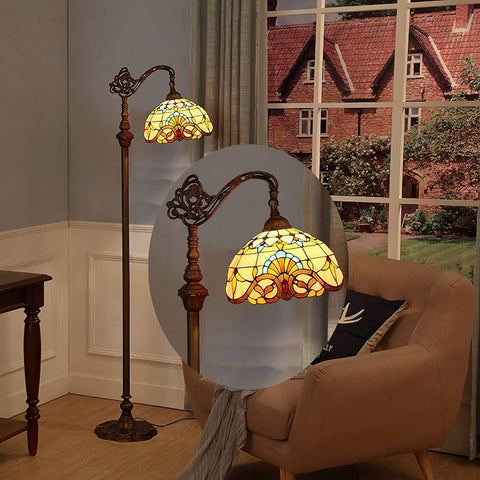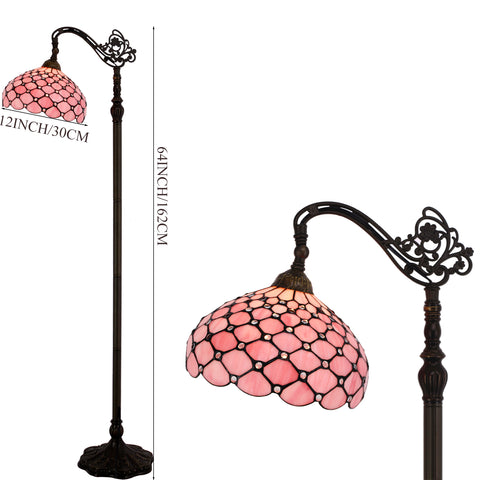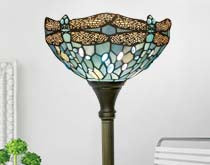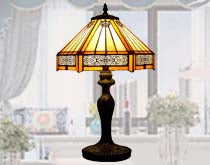Where to Put Floor Lamp in Living Room
A well-lit living room creates an inviting atmosphere that sets the tone for relaxation, conversation, and enjoyment. While overhead lighting is functional, incorporating floor lamps into your living space can add warmth, depth, and character.
But where precisely should you position these versatile lighting fixtures for maximum impact? This comprehensive guide will provide practical insights and creative ideas to strategically place floor lamps in your living room, making it a cozy and visually appealing haven.
Floor lamps are versatile lighting solutions that offer both functional and decorative benefits. They can illuminate dark corners, highlight architectural features, or create a cozy reading nook.
By strategically positioning floor lamps throughout your living room, you can achieve a balanced and layered lighting scheme that enhances the overall ambiance and functionality of the space.Click here to view more tiffany lamps.
Reading Nook

Creating a designated reading nook for book lovers is essential in the living room. Position a floor lamp beside your cozy reading chair or sectioned-off nook area. Prioritize lamps with adjustable components like swiveling shades or poles that adjust vertically.
This allows you to precisely angle the lighting onto the pages of your book for glare-free, strain-free reading sessions. A classic reading lamp style with a weighted circular base offers ideal stability.
Architectural Highlights
Does your living room boast show-stopping architectural elements you wish to emphasize? A floor lamp can magnificently highlight these features. If you have a stately fireplace, place a lamp on each side, directing the shades to wash the facade in a warm, focused light.
For impressive built-in bookcases or large bright windows, station a lamp immediately alongside the architectural piece to draw the eye naturally toward it when illuminated.
Dim Corners
Even well-lit living rooms often have dimly lit corners or hallway entrances that disrupt the inviting ambiance. Thoughtfully positioning a floor lamp in these gloomy spaces will brighten the area. Look for models with adjustable shades that allow you to precisely angle the beam of light into any dull nook or cranny. Or opt for lamps with taller poles that can illuminate dark upper corners.
Living Room Layout

Take a surveying look at your living room's layout and think about which areas could benefit from task or ambient lighting. Is there a cozy reading chair that needs a perfectly placed lamp for bookworm sessions? Or a cozier and more functional sofa section with added floor lamp lighting? Purposefully place lamps in these zones to establish defined lighting areas while avoiding major walking trails to prevent obstructions.
Layered Ambiance
Crafting the perfect ambiance is all about layering various lighting elements together. While overhead lighting offers broad room illumination, floor lamps introduce warm, focused lighting to add dimension.
Incorporate floor lamps, table lamps, strategically mounted wall sconces, and even candles scattered throughout to create a customizable lighting atmosphere. Rely more heavily on lamps for a calm movie night mood, but amplify with overhead lighting when entertaining.
Living Room Center
Placing a floor lamp in the middle of your living room is a functional lighting solution. It adds a decorative element to the space. Choosing a Tiffany floor lamp with a stylish and classic design can seamlessly blend into the décor of your living room while becoming an eye-catching focal point.
Look for lamps with adjustable features such as adjustable height settings to customize the lighting according to your preferences. This strategic placement ensures even illumination throughout the room. It creates a warm and inviting ambiance for gatherings with family and friends.
Home Office
In today's age of remote work, many living rooms have become multi-purpose spaces that incorporate a home office nook or dedicated workspace. Proper lighting is crucial for reducing eye strain and increasing productivity in these areas.
A floor lamp can provide the perfect task lighting solution behind your desk or on your work table. Look for models with adjustable components that direct the light exactly where you need it while minimizing disruptive shadows or glare on your computer screen.
Sculptural Lighting
While functionality is vital, floor lamps can also be statement pieces that elevate your living room's overall aesthetic. Consider investing in a sculptural or artfully designed lamp that complements your space's style while providing warm, ambient lighting. From slender arched lamps with metallic finishes to chunky ceramic bases in eye-catching colors or patterns - the right design can add a chic, artistic touch that enriches your decor story.
Entryways
Does your living room flow into a foyer, hallway, or other transitional space? Illuminating them with a floor lamp ensures these buffer zones feel seamlessly incorporated instead of dim and disconnected. Position a stylish light in the corner near the opening to gently guide the eye from one space to the next while preventing abrupt drops in lighting levels. This makes foot traffic patterns feel continuous and welcoming.
Home Automation System
Invest in an intelligent floor lamp that integrates seamlessly with your home automation system. This allows you to customize and control lighting scenes and schedules for the perfect ambiance at the touch of a button or voice command. Quickly dim the lamps for a cozy movie night, or schedule them to gradually brighten in the evenings, guiding you into a warmly lit living space after work.
Tips for Choosing the Right Lamp Height and Shade Size

While positioning your floor lamps is crucial, selecting the right size and harmoniously combining them with other lighting elements is equally essential for achieving a well-lit and visually appealing living room. To ensure your floor lamps make a stunning impact, keep these crucial tips in mind
1. Lamp Height
- Aim for a lamp height around two-thirds the height of surrounding furnishings or architectural features for a balanced look. This guideline helps ensure the lamp doesn't appear too short or towering about its surroundings.
- Taller lamps can help fill the vertical space and provide ample light coverage in rooms with high ceilings. Lamps that are too short may get lost in the vastness of a room with soaring ceilings.
- Shorter lamps are better to avoid a cramped, top-heavy feel in rooms with lower ceilings. Opt for lamps complementing the room's proportions without making the space feel closed in or overwhelming.
2. Shade Size
- The shade's diameter should be approximately one-third the height of the lamp base. This ratio helps maintain a visually appealing balance between the shade and the lamp's overall silhouette.
- A shade too small may not provide sufficient light dispersion, leaving some areas of the room feeling dim or shadowy.
- An oversized shade could overwhelm the space and appear disproportionate, potentially casting harsh or uneven light.
3. Shade Shape
- Empire or bell shades direct light downward, making them ideal for task lighting in reading nooks or work areas where focused illumination is needed.
- Drum shades offer more ambient, diffused light that's perfect for creating a cozy atmosphere throughout the living room. Their versatile shape distributes light evenly, eliminating harsh shadows or bright spots.
4. Bulb Brightness
- Choose a bulb with an appropriate brightness level to suit the intended function of the lamp and the ambiance of the room.
- For reading or task lighting, opt for bulbs with higher wattage or lumens to ensure ample illumination.
- Conversely, for creating a relaxed ambiance, consider softer, lower-wattage bulbs that emit warm, diffused light.
5. Style Consistency
- Ensure the style of the lamp complements the overall aesthetic of the room.
- Whether your decor leans towards modern, traditional, or eclectic, select a lamp that harmonizes with existing furnishings and decor elements.
- Consistency in style creates a cohesive look and enhances the overall ambiance of the space.
6. Material and Texture
- Choose materials that complement your decor style and add visual interest to the room. For example, lamps with metallic finishes can add a touch of sophistication.
- At the same time, those with natural textures like wood or rattan can bring warmth and texture to the space.
- Consider how the lamp's material and texture interact with other elements in the room to create a cohesive and inviting atmosphere.
Suggestions for Combining Floor Lamps with Other Lighting Sources
Continuing the journey towards a flawlessly illuminated living room, let's explore how to seamlessly integrate your floor lamps with other lighting fixtures. By strategically layering various light sources, you can achieve a functional and aesthetically pleasing space.
1. Layer with Table Lamps or Torchiere Lamps
Combining floor lamps with table lamps or torchiere lamps adds depth and dimension to the space, creating a dynamic interplay of light and shadow. This combination of ambient and focused lighting allows for customizing illumination levels for different activities or moods, ensuring the living room is always well-lit and inviting.
2. Incorporate Wall Sconces or Recessed Lighting
Wall sconces can highlight artwork or architectural features, drawing the eye to these focal points and adding visual interest to the space. Recessed lighting provides a subtle, streamlined look that complements modern décor styles while offering functional illumination from above.
3. Coordinate Bulb Warmth and Intensity
Cool, bright bulbs work well for task lighting, providing ample illumination for activities like reading or working. Warm, soft bulbs create a cozier atmosphere, ideal for relaxing or entertaining in the living room. Aim for a cohesive blend of temperatures and brightness levels throughout the room to create a harmonious, well-balanced lighting environment.
4. Consider Fixture Finishes and Materials
Mixing metals like brass and chrome can lend an eclectic, curated feel, adding visual interest and personality to the living room's design aesthetic. Sticking to a uniform finish like oil-rubbed bronze or matte black creates a more streamlined aesthetic, allowing the lighting fixtures to blend seamlessly with the room's color scheme and decor.
5. Incorporate Smart Lighting or Dimmer Switches
Smart lighting technology or dimmer switches allow for effortless adjustment of brightness levels and ambiance with the touch of a button or voice command. This level of control ensures your living room always appears perfectly illuminated for any occasion, whether hosting a gathering, enjoying a cozy night in, or simply needing bright light for tasks.
Conclusion
The strategic placement of floor lamps is essential for creating a warm, inviting, and functionally brilliant living room. Combining floor lamps with other lighting sources like table lamps and wall sconces lets you layer ambient and focused light for depth and dimension.
Pay close attention to lamp heights, shade sizes, and bulb temperatures to achieve a cohesive, well-balanced lighting scheme. With thoughtful lighting design, you can transform your living room into a true oasis of comfort, style, and radiant ambiance.
You can click to learn: What type of floor lamp gives the most light?

























